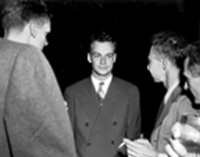Read works of Richard Feynman at 小说之家 | |||
He assisted in the development of the atomic bomb and was a member of the panel that investigated the Space Shuttle Challenger disaster. In addition to his work in theoretical physics, Feynman has been credited with pioneering the field of quantum computing, and introducing the concept of nanotechnology. He held the Richard Chace Tolman professorship in theoretical physics at the California Institute of Technology.
Feynman was a keen popularizer of physics through both books and lectures, notably a 1959 talk on top-down nanotechnology called There's Plenty of Room at the Bottom and The Feynman Lectures on Physics. Feynman also became known through his semi-autobiographical books (Surely You're Joking, Mr. Feynman! and What Do You Care What Other People Think?) and books written about him, such as Tuva or Bust!
He was regarded as an eccentric and free spirit. He studied Maya hieroglyphs, was a prankster, juggler, safecracker, bongo player, and a proud amateur painter.
Feynman also had a deep interest in biology, and was a friend of the geneticist and microbiologist Esther Lederberg, who developed replica plating and discovered bacteriophage lambda. They had several mutual physicist friends who, after beginning their careers in nuclear research, moved for moral reasons into genetics, among them Leó Szilárd, Guido Pontecorvo, and Aaron Novick.
